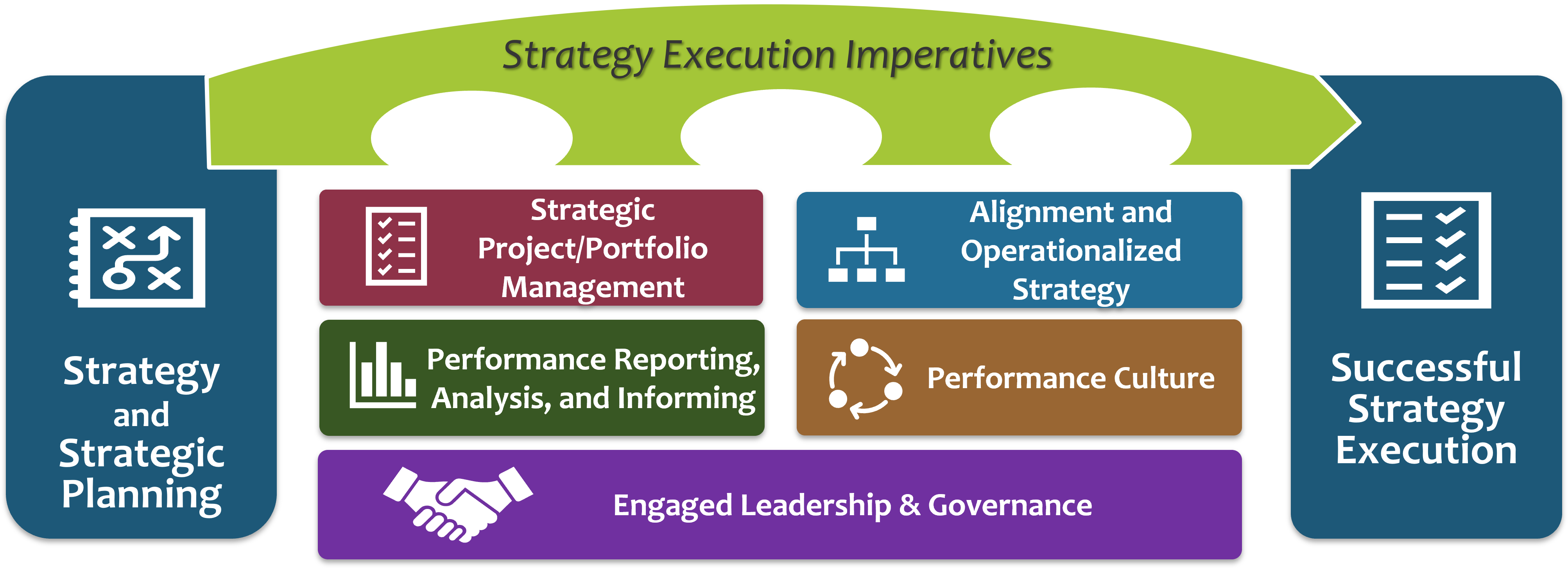 Regardless of what type of organization you are a part of, developing a winning strategy is just the beginning of the performance journey. The real test lies in being able to execute your strategy effectively. Unfortunately, successful strategy execution is elusive, riddled with complex challenges, and often fails to deliver expected outcomes.
Regardless of what type of organization you are a part of, developing a winning strategy is just the beginning of the performance journey. The real test lies in being able to execute your strategy effectively. Unfortunately, successful strategy execution is elusive, riddled with complex challenges, and often fails to deliver expected outcomes.
There are tons of studies that demonstrate the difficulties of strategy execution:
- Only 2% of leaders are confident their organization can achieve 80 – 100% of their strategic goals
- 67% of well-formulated strategies fail due to poor execution
- 58% of organizations believe their performance management systems are insufficient for monitoring strategy performance
- 71% of employees cannot recognize their own organization’s strategy in a multiple-choice question
- 85% of leadership teams spend less than one hour per month on strategy and 50% spend no time at all on strategy
- 92% of organizations reported they do not track the key performance indicators to tell them how well they are doing in competition
While the success rate of strategy execution can vary widely depending on various factors including the industry, the specific strategy and how success is defined, there is no universally accepted percentage of organizations successful in strategy implementation and execution. However, research and studies over the past two decades have consistently shown a significant number of organizations continue to struggle with strategy execution and often fall short of success.
As you manage your team through the strategy execution process, watch for the common icebergs that typically sink your ship. Those icebergs are found within the five strategy execution imperatives shown below.

Engaged Leadership and Governance
The first of these imperatives is Engaged Leadership and Governance. In the context of strategy execution, the intricate dance between leadership and governance assumes a pivotal role. These two facets wield substantial influence over an organization’s capacity to effectively breathe life into its strategic endeavors. Frequently, leaders stumble when it comes to articulating an inspiring vision or establishing well-defined strategic objectives. This failure, in turn, can cast a shadow of confusion upon their workforce, leaving them adrift. The foundation of success, it’s worth noting, lies in the clarity and decisiveness that effective leadership brings to the table.
But there’s another dimension to this partnership—one that revolves around the allocation of resources, encompassing both financial and human capital, both of which are vital for driving successful strategy execution. When strategy fails to take pole position in the organizational hierarchy or governance mechanisms falter in ensuring resource allocation aligns seamlessly with strategic priorities, it often leads to frustration due to the shortfall in crucial funding, talent, or infrastructure required for the successful execution of the strategy.
Moreover, governance bears the weighty responsibility of overseeing and enforcing accountability in the realm of strategy execution. The absence of such accountability at the upper echelons of leadership frequently cascades into a lack of follow-through on assigned strategic initiatives, resulting in missed deadlines, incomplete projects, and a woeful inadequacy in performance tracking. This failure invariably seeps into the very fabric of the organization’s culture. When leaders fail to exemplify the desired behaviors, or when governance neglects to nurture a culture steeped in accountability and performance, the organization tends to entrench itself in change-resistant terrain, where employees display apathy towards addressing or prioritizing strategy execution.
Performance Culture
Shaping a Performance Culture stands as the critical cornerstone for effective strategy execution. It’s all about spotlighting clear organizational objectives and promoting a deep understanding among employees at every level of how their individual contributions harmonize with the organization’s strategic priorities.
This desired harmonious state often falters within organizations where alignment is vague or non-existent. When individual goals fail to synchronize with overarching strategic objectives and direction, employees may veer toward tasks that bear no relevance to the organization’s strategy, ultimately resulting in subpar execution.
In the wake of disruptions in the work environment brought about by events like COVID, the landscape of organizational culture has undergone massive shifts. With the emergence of hybrid work environments, remote work arrangements, a surge in social responsibility, and a dynamic interplay of generational values, every organization seems to be struggling to define its new cultural identity. Embracing innovation and flexibility is paramount, but this transformation should not sidestep the necessary foundation of accountability.
Accountability, an undisputable cornerstone of a performance culture, expects employees to shoulder their responsibilities, deliver results, and accept the consequences of their actions. While many organizations tout the virtues of accountability, it’s a topic that sometimes tiptoes in today’s workplace due to the perception that it may not align with contemporary social norms. However, organizations that fail to maintain uniform standards for leaders and employees, establish explicit expectations, and transparently communicate these expectations, invariably fall short in the pursuit of their strategic objectives.
Another pivotal dimension within the realm of culture is cultivating the concept of continuous improvement. In a true performance-oriented culture, the emphasis lies on fostering a climate that values perpetual progress and learning. Here, employees are empowered to identify areas ripe for enhancement and take proactive measures to enact the requisite changes. This approach not only enables the organization to adapt quickly but also encourages employees to take ownership of their growth and the organization’s overall success.
Alignment and Operationalized Strategy
The imperative of Alignment and Operationalized Strategy stands as a pivotal force shaping the landscape of strategy execution. When an organization attains alignment, it ushers in three fundamental conditions that wield a profoundly positive influence on the execution of strategy.
The first of these conditions is the presence of Clear Direction. In this scenario, every member of the organization possesses a clear understanding of the strategic goals, priorities, and the overarching outcomes the organization aims to accomplish. This clarity not only increases employee engagement but also instills a profound sense of individual purpose. Employees perceive how their individual efforts harmonize with the overarching aims of the organization’s strategy. This, in turn, fuels their motivation and commitment to go the extra mile, ensuring the organization’s success in executing its strategy.
In organizations where strategy finds alignment, there’s a high probability that resources are allocated with precision and efficacy, cascading into the wellspring of strategy execution. This attention to Resource Allocation ensures that the requisite funds, talent, and time are thoughtfully allocated to fuel the engine of strategy execution.
Operationalizing Strategy constitutes the art of translating high-level strategies into tangible, actionable steps and initiatives throughout all levels of the organization. This process serves as a compass, offering a crystal-clear roadmap delineating precisely how the organization intends to accomplish its strategic objectives in a practical and systematic manner. It often entails the description of roles and the establishment of unambiguous lines of accountability, both of which are indispensable for tracking progress. This undertaking also involves the articulation of key performance indicators (KPIs) and other metrics, simplifying the task of gauging and evaluating progress.
In essence, Operationalizing Strategy serves as the bridge that transforms abstract strategic concepts into concrete, definable actions. It emerges as an important facet of strategy execution, underpinning the organization’s voyage toward the realization of its long-term goals and aspirations.
Strategic Project/Portfolio Management
The area of Strategic Project/Portfolio Management emerges as the fourth pivotal imperative in the realm of strategy execution. As previously alluded to, the often-encountered misalignment in resource management can pose a substantial barrier to the successful execution of strategy. It’s not uncommon for organizations to find themselves grappling with the challenge of attempting to juggle an excessive number of initiatives, often without the adequate resourcing or proficient management necessary for success.
In the past three decades, this particular juncture is where I’ve witnessed organizations frequently stumble and face substantial challenges. Managing this aspect effectively and maintaining a comprehensive awareness of all ongoing initiatives within the organization is nothing short of critical for the seamless execution of your strategy. Project and portfolio management must be tightly aligned with the strategic goals of the organization. This alignment serves as a linchpin, ensuring that the strategic initiatives indispensable for the successful execution of your organization’s strategy are not only under vigilant scrutiny but also being managed skillfully.
Effective project and portfolio management helps to ensure that resources are strategically aligned to optimize the organization’s execution expertise by prioritizing those initiatives that have the most profound impact on your strategy. Moreover, it offers the flexibility for the organization to become more agile…to make real-time adjustments, thanks to the embedded mechanisms for monitoring progress and managing risks. Additionally, it furnishes leaders with a wealth of relevant and timely data, empowering them to make data informed decisions. Often, this domain encompasses change management strategies, an invaluable asset to aid employees in navigating the transitions ushered in by new initiatives or processes in pursuit of the organization’s strategic objectives.
Performance Reporting, Analysis, and Informing
The final imperative in our journey is Performance Reporting, Analysis, and Informing—a key element in the landscape of strategy execution. This domain assumes a pivotal role by furnishing organizations with indispensable insights, bolstering accountability, and fortifying decision-making through the utilization of accurate, meaningful, and timely data.
Performance analysis and reporting act as a magnifying glass, providing insights and perspectives on how effectively an organization is advancing toward the attainment of its strategic goals. It serves as a beacon, allowing leaders, employees, and stakeholders to gauge the organization’s progress in the realm of strategy execution. Through constant performance monitoring and reporting, organizations ensure that every task, across all corners of the organization, aligns seamlessly with the overarching objectives of the organizational strategy.
Moreover, this practice illuminates areas where the organization may falter or contend with challenges in executing the strategy. When executed in a timely fashion, it becomes a catalyst for early intervention and enabling a proactive approach toward corrective actions. This approach assists in building accountability throughout the organization, cultivating a profound sense of ownership and responsibility among individuals for achieving specific goals integral to the organization’s success.
Furthermore, performance analysis and reporting are the architects of a culture immersed in learning and continuous improvement. They cast the foundation of trust and confidence among stakeholders, affirming the organization’s competence in strategy execution. This practice also transforms the organization into an agile entity, primed to adapt to the ever-evolving landscape of market conditions, emergent opportunities, and unexpected challenges. Above all, it serves as a litmus test, validating whether the strategy is delivering the desired outcomes as envisioned.
Conclusion
These five imperatives form the basis for our newly developed Strategy Execution Professional certification program. For more information: https://strategymanage.com/practical-strategy-execution-certification/
Source: Cascade Team, https://www.cascade.app/blog/51-strategy-statistics, November 2022.
Terry is Balanced Scorecard Institute's Director of Training and Senior Associate with over 30 years of experience working in both the private and public sectors.

